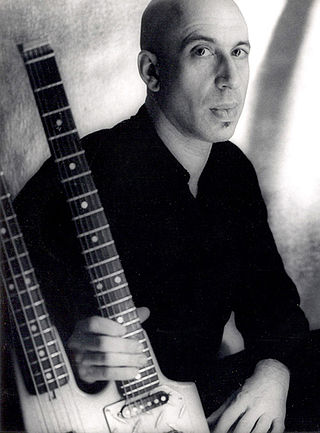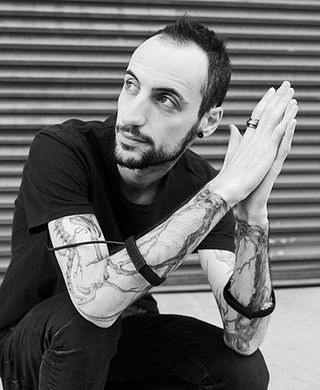Related Research Articles
Electronic music broadly is a group of music genres that employ electronic musical instruments, circuitry-based music technology and software, or general-purpose electronics in its creation. It includes both music made using electronic and electromechanical means. Pure electronic instruments depended entirely on circuitry-based sound generation, for instance using devices such as an electronic oscillator, theremin, or synthesizer. Electromechanical instruments can have mechanical parts such as strings, hammers, and electric elements including magnetic pickups, power amplifiers and loudspeakers. Such electromechanical devices include the telharmonium, Hammond organ, electric piano and electric guitar.

An electronic musical instrument or electrophone is a musical instrument that produces sound using electronic circuitry. Such an instrument sounds by outputting an electrical, electronic or digital audio signal that ultimately is plugged into a power amplifier which drives a loudspeaker, creating the sound heard by the performer and listener.

Musical composition can refer to an original piece or work of music, either vocal or instrumental, the structure of a musical piece or to the process of creating or writing a new piece of music. People who create new compositions are called composers. Composers of primarily songs are usually called songwriters; with songs, the person who writes lyrics for a song is the lyricist. In many cultures, including Western classical music, the act of composing typically includes the creation of music notation, such as a sheet music "score", which is then performed by the composer or by other musicians. In popular music and traditional music, songwriting may involve the creation of a basic outline of the song, called the lead sheet, which sets out the melody, lyrics and chord progression. In classical music, orchestration is typically done by the composer, but in musical theatre and in pop music, songwriters may hire an arranger to do the orchestration. In some cases, a pop or traditional songwriter may not use written notation at all and instead compose the song in their mind and then play, sing or record it from memory. In jazz and popular music, notable sound recordings by influential performers are given the weight that written or printed scores play in classical music.
Noise music is a genre of music that is characterised by the expressive use of noise. This type of music tends to challenge the distinction that is made in conventional musical practices between musical and non-musical sound. Noise music includes a wide range of musical styles and sound-based creative practices that feature noise as a primary aspect.
Glitch is a genre of electronic music that emerged in the 1990s which is distinguished by the deliberate use of glitch-based audio media and other sonic artifacts.

Alvin Augustus Lucier Jr. was an American composer of experimental music and sound installations that explore acoustic phenomena and auditory perception. A long-time music professor at Wesleyan University in Middletown, Connecticut, Lucier was a member of the influential Sonic Arts Union, which included Robert Ashley, David Behrman, and Gordon Mumma. Much of his work is influenced by science and explores the physical properties of sound itself: resonance of spaces, phase interference between closely tuned pitches, and the transmission of sound through physical media.

Christian Marclay is a visual artist and composer. He holds both American and Swiss nationality.
20th-century classical music is art music that was written between the years 1901 and 2000, inclusive. Musical style diverged during the 20th century as it never had previously, so this century was without a dominant style. Modernism, impressionism, and post-romanticism can all be traced to the decades before the turn of the 20th century, but can be included because they evolved beyond the musical boundaries of the 19th-century styles that were part of the earlier common practice period. Neoclassicism and expressionism came mostly after 1900. Minimalism started much later in the century and can be seen as a change from the modern to postmodern era, although some date postmodernism from as early as about 1930. Aleatory, atonality, serialism, musique concrète, electronic music, and concept music were all developed during the century. Jazz and ethnic folk music became important influences on many composers during this century.
In music, montage or sound collage is a technique where newly branded sound objects or compositions, including songs, are created from collage, also known as Musique concrète. This is often done through the use of sampling, while some sound collages are produced by gluing together sectors of different vinyl records. Like its visual cousin, sound collage works may have a completely different effect than that of the component parts, even if the original parts are recognizable or from a single source. Audio collage was a feature of the audio art of John Cage, Fluxus, postmodern hip-hop and postconceptual digital art.
Joan Linda La Barbara is an American vocalist and composer known for her explorations of non-conventional or "extended" vocal techniques. Considered to be a vocal virtuoso in the field of contemporary music, she is credited with advancing a new vocabulary of vocal sounds including trills, whispers, cries, sighs, inhaled tones, and multiphonics.
Electroacoustic music is a genre of popular and Western art music in which composers use technology to manipulate the timbres of acoustic sounds, sometimes by using audio signal processing, such as reverb or harmonizing, on acoustical instruments. It originated around the middle of the 20th century, following the incorporation of electric sound production into compositional practice. The initial developments in electroacoustic music composition to fixed media during the 20th century are associated with the activities of the Groupe de recherches musicales at the ORTF in Paris, the home of musique concrète, the Studio for Electronic Music in Cologne, where the focus was on the composition of elektronische Musik, and the Columbia-Princeton Electronic Music Center in New York City, where tape music, electronic music, and computer music were all explored. Practical electronic music instruments began to appear in the early 20th century.

Elliott Sharp is an American contemporary classical composer, multi-instrumentalist, performer, author, and visual artist.
A tactile transducer or "bass shaker" is a device which is made on the principle that low bass frequencies can be felt as well as heard. They can be compared with a common loudspeaker, just that the diaphragm is missing. Instead, another object is used as a diaphragm. A shaker transmits low-frequency vibrations into various surfaces so that they can be felt by people. This is called tactile sound. Tactile transducers may augment or in some cases substitute for a subwoofer. One benefit of tactile transducers is they produce little or no noise, if properly installed, as compared with a subwoofer speaker enclosure.

Alan Licht is an American guitarist and composer, whose work combines elements of pop, noise, free jazz and minimalism. He is also a writer and journalist.

An experimental musical instrument is a musical instrument that modifies or extends an existing instrument or class of instruments, or defines or creates a new class of instrument. Some are created through simple modifications, such as cracked cymbals or metal objects inserted between piano strings in a prepared piano. Some experimental instruments are created from household items like a homemade mute for brass instruments such as bathtub plugs. Other experimental instruments are created from electronic spare parts, or by mixing acoustic instruments with electric components.
Peter Cusack is an English artist and musician who is a member of CRiSAP, and is a research staff member and founding member of the London College of Communication in the University of the Arts London. He was a founding member and director of the London Musicians' Collective.
Experimental music is a general label for any music or music genre that pushes existing boundaries and genre definitions. Experimental compositional practice is defined broadly by exploratory sensibilities radically opposed to, and questioning of, institutionalized compositional, performing, and aesthetic conventions in music. Elements of experimental music include indeterminacy, in which the composer introduces the elements of chance or unpredictability with regard to either the composition or its performance. Artists may approach a hybrid of disparate styles or incorporate unorthodox and unique elements.
Live electronic music is a form of music that can include traditional electronic sound-generating devices, modified electric musical instruments, hacked sound generating technologies, and computers. Initially the practice developed in reaction to sound-based composition for fixed media such as musique concrète, electronic music and early computer music. Musical improvisation often plays a large role in the performance of this music. The timbres of various sounds may be transformed extensively using devices such as amplifiers, filters, ring modulators and other forms of circuitry. Real-time generation and manipulation of audio using live coding is now commonplace.
Ulrich Krieger is a German contemporary composer, performer, improviser and experimental rock musician based in Los Angeles.

Marco Donnarumma is an Italian performance artist, new media artist and scholar based in Berlin. His work addresses the relationship between body, politics and technology. He is widely known for his performances fusing sound, computation and biotechnology. Ritual, shock and entrainment are key elements to his aesthetics. Donnarumma is often associated with cyborg and posthuman artists and is acknowledged for his contribution to human-machine interfacing through the unconventional use of muscle sound and biofeedback. From 2016 to 2018 he was a Research Fellow at Berlin University of the Arts in collaboration with the Neurorobotics Research Lab at Beuth University of Applied Sciences Berlin. In 2019, together with bioartist Margherita Pevere and media artist Andrea Familari, he co-founded the artists group for hybrid live art Fronte Vacuo.
References
- 1 2 "Nicolas Collins Interview". media.hyperreal.org. Retrieved 17 February 2019.
- ↑ "Nicolas Collins: Prose Scores". www.nicolascollins.com. Retrieved 17 February 2019.
- ↑ "Nicolas Collins, Nonpop New Music Composer". www.kalvos.org. Retrieved 17 February 2019.
- ↑ "Nicolas Collins". www.lovely.com. Retrieved 17 February 2019.
- ↑ "Nicolas Collins with Ben Neill and Andrea Parkins+ Loud Objects – ISSUE PROJECT ROOM". Archived from the original on 2011-09-21. Retrieved 2010-08-30.
- ↑ "Leonardo On-Line: About Nicolas Collins". Archived from the original on 2011-07-16. Retrieved 2010-08-30.
- ↑ "Faculty alpha listing : SAIC - School of the Art Institute of Chicago". www.saic.edu. Archived from the original on 2010-05-27.
- ↑ "Whitney Museum of American Art: Christian Marclay: Festival". Archived from the original on 2010-08-30. Retrieved 2010-08-30.
- ↑ "Hardware Hacking with Nicolas Collins - ausland-berlin". ausland-berlin.de. Retrieved 17 February 2019.
- ↑ Kraus, Pat (24 March 2014). "MEL prehistory 1". Musical Electronics Library. Retrieved 15 July 2014.